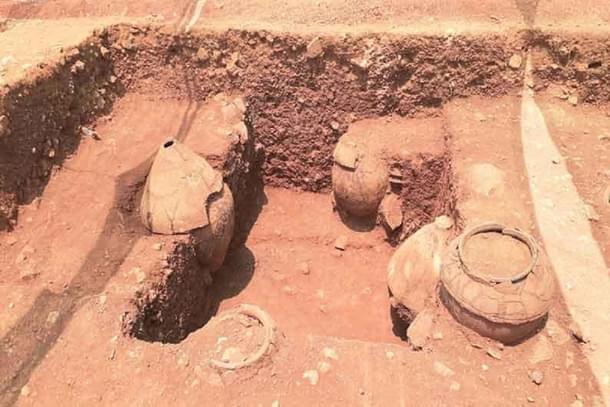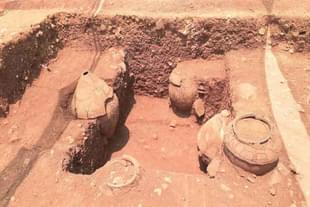Heritage
Adichanallur: Significance Of The Iron-Age Burial Site In India's Ancient History
S Krishnan
Aug 10, 2023, 12:17 PM | Updated Feb 11, 2025, 04:24 PM IST
Save & read from anywhere!
Bookmark stories for easy access on any device or the Swarajya app.


Adichanallur is in the news again. Last week, Honourable Finance Minister Nirmala Sitharaman laid the foundation stone for a world class museum at this iconic site.
When it becomes fully functional, it will indeed be an excellent place to get a glimpse into an ancient civilisation of the world.
The archaeological site, discovered during the late 19th century, has a chequered history. It is an iron-age burial site, one of the largest found in India. It is situated on the banks of River Tamirabarani, between Tirunelveli & the pilgrimage site of Tiruchendur.
A German archaeologist, Dr Jagor discovered the site first and did the excavation in 1876. He found several artefacts, including earthen utensils and iron implements.
Encouraged by this, British Government employed Dr Alexander Rea did an extensive excavation during 1899-1900. He was instrumental in coming up with a number of significant observations about this site.
He opined that this must have been a seaport earlier and the sea receded later, making nearby Korkai as a primary seaport of the Pandya Kings.
Post-independence, few surveys took place at the site and T Satyamurthy from the Archaeological Survey of India (ASI) did another round of excavations during 2004-05.
The Location
The site is adjacent to the village Adichanallur in an elevated place known as Parambu. Rea did a detailed survey encompassing an area of 114 acres.
This was basically a burial site that belongs to Iron age. The burials were done using the urns, a practice which was in vogue during ancient times in Tamilagam. The urns were elongated, large pots of thick red earthen ware averaging less than a yard in diameter. All were closed using a flat, conical lid. Many of the urns excavated contained skeletons.
The study of skeletons found in the site revealed that the population was varied and cannot be pinpointed to a particular group or race. Their physical similarities match with skeletal remains from Harappa, as per researcher K A R Kennedy.
The burial pattern also showed an interesting practice where the royals and commoners are buried at different places. Royals burial site had objects like spears, diadems made in gold and swords used by them.
In Literature
In Tamil Sangam literature, there are many references of such types of burials using urn, which is called as ‘Thazhi’ in Tamil.
In the text Purananooru, the poet Aiyur Mudavanaar wonders if an urn was to be made for Chola King Killivalavan, does it require quantity of sand as large as the Himalayas ?
'Aṉṉōr kavikkum kaṇṇakaṉ taazhi
vaṉaital vēṭṭaṉai ayiṉ eṉaiyatūm
irunilam tikiriyā perumalai maṇṇā,
vaṉaital ollumō niṉakkē'
says the verse 228.
Tamil epic Manimekalai mentions about various practices followed for disposal of dead.
Suduvor Iduvor Todukuzhi Paduvor
Talvayinadaipor Tazhiyil Kavippor
Burying people in urn is one of the practices followed apart from cremation, leaving them to the elements of nature, burying in ground and putting them in cellars.
The practice of putting the bodies in an urn is called as Kavithal in Tamil. Of all these practices, urn burial has the largest reference in the literature. In Adichanallur, the urn burial was also done after leaving the body for days in open ground.
Burying the things used by the individuals along with him/her was also a practice followed here and hence the site brought out a number of artefacts while unearthing the urns.
The artefacts found from the site includes weapons, vessels, personal ornaments in bronze, few gold ornaments, beads, stone implements used for grinding, and husks of rice, millets and green gram. The copper objects found include copper bangles and rings.
The iron artefacts which predominantly included swords, arrows and spears were pointed downwards, as if they were thrust when the burial took place.
The metallurgy of objects found showed a well advanced civilisation with vessels including very thin (0.2 mm) and thick found. Their manufacturing points out very high workmanship.
Habitation Site
A habitation site was also found and excavated next to the burial site. The artefacts found in the habitation site includes ring stand, storage jars, dish and bowl.
Apart from them, a potters' kiln and place which is likely to be a codex bead industry were also found. Carnelian beads were also found in the site which indicates a trade relationship with other parts of the country like Gujarat.
One of the important artefacts found in the site is a potsherd with a graffiti. It shows a figure of a female along with a plant. On the side, a deer was seen and below a crocodile was drawn using a line. A crane was also seen holding a fish.
Researchers say that this picture depicts the presence of ‘mother goddess’ worship. Tamil literature mentions about Kotravai as the mother goddess. Deer was her vehicle (vahana). Rea also excavated a small toy-like object which resembles the Mother goddess. The features resemble those in the graffiti.
So this is one of the earliest reference of the Kotravai worship. Interestingly the deer depicted looks similar to the ones living in nearby Vallanadu. There is also a bronze object found which also looks like a Vallanadu deer.
Corroborating the mother goddess worship here, Rea found a small idol which resembled a mother. Some of the researchers link this with Thavvai (Jyeshta), a goddess worshipped in ancient Tamilagam.
Many of the artefacts has a fish symbol, sometimes two fishes (Irattai Kayal). This was the symbol of Pandyas. This region had the second capital of Pandyas during the Sangam days.
So this corroborates clearly with the history that Pandyas were ruling this place.
Recently copper coins were also excavated from the site. They had the Pandya symbol of fish along with Tortoises in a small tank.
Presence of Tortoises in tanks is a notable feature of Pandyan ‘Peruvazhuthi’ coins. The presence of the picture of ‘tree’ in these coins is similar to that of the coins of Uddehika Kings in Rajasthan, says the well known scholar and expert of Pandya coins, R Krishnamoorthi.
Tortoise in a tank is associated with the Yajnas, as they were performed by the Pandyas.
Dates
The chronology of Adichanallur was arrived on the basis of radio carbon dating analysis.
According to ASI, fourteen AMS dates were received based on the analysis of the samples, of which two were contaminated. Three dates came from the early historical level which falls between 201 BCE and 467 BCE and seven dates came from iron-age phase, between 665 BCE to 1384 BCE.
Interestingly, the date of high bronze recovered from the site goes back to 13th century BCE. Likewise, the gold was also used during the same period.
Specifically, the millet recovered from the site is dated at 1384 BCE and the husk at 1257 BCE, making this the oldest, in terms of timelines in Tamil Nadu.
The Museum
After the 2004-2005 survey there was a lull in terms of the activities around this site.
It was the Bharatiya Janata Party (BJP) government at the centre which published a detailed report on the excavation during 2019. Following that up, Finance Minister Sitharaman announced the plan to develop five iconic archaeological sites as part of the Budget 2020 and Adichanallur was one of these sites.
Under this development plan, for the first time in India, an in-situ archaeological museum will be constructed at Adichanallur.
This will house the artefacts excavated at the site. It will have display galleries, souvenir shop and a cafeteria. There is also a proposal to have an amphi-theatre which will provide a sound and light show.
Another important aspect of the museum is that the trenches will be showcased using the toughened glass on top. The visitors can see the urns and the objects buried along with that from the top through this glass.
As such, the day is not far away that Adichanallur will live up to the name of an iconic site proudly displaying our ancient culture and heritage.





